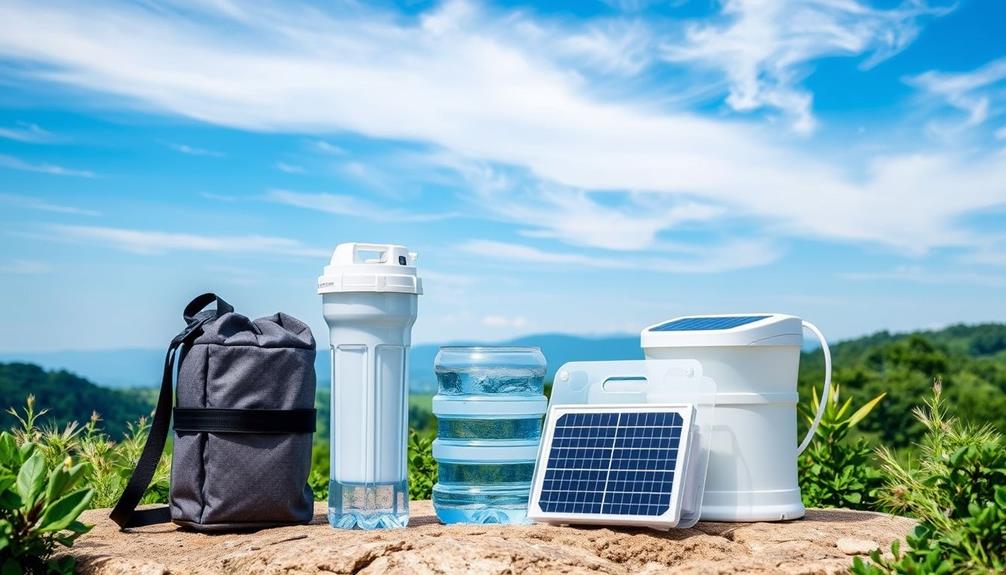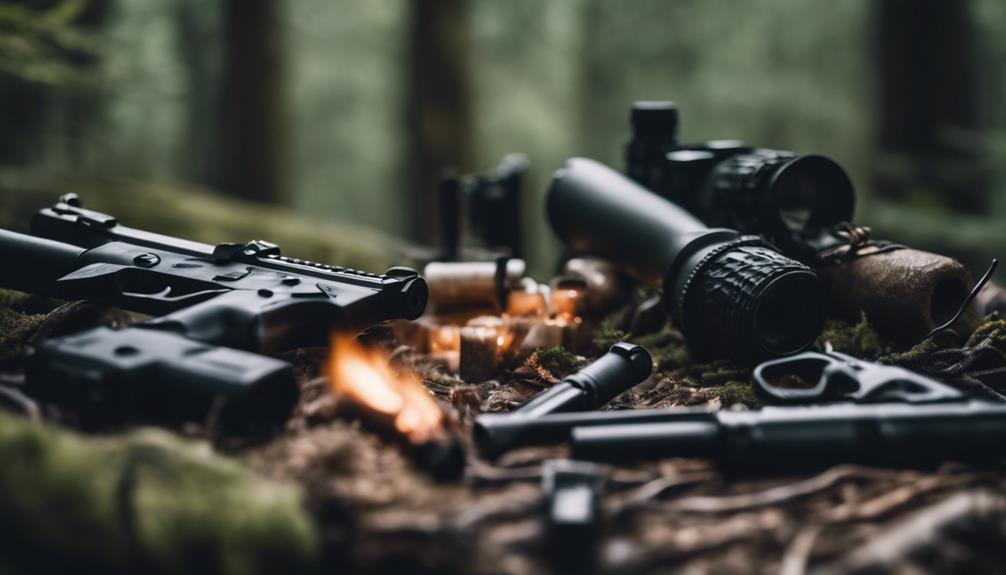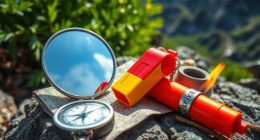When packing your bug-out bag, focus on essentials that guarantee your survival. Start with sturdy clothing, including moisture-wicking layers and durable footwear. Don't forget personal hygiene items to maintain health. Make certain to include enough water containers and filtration options, plus non-perishable food like dehydrated meals and jerky. A portable bivvy for shelter and a thermal sleeping bag are essential for warmth. Equip yourself with survival tools, a thorough first aid kit, and important navigation gear. Each item plays a significant role. Keep going, and you'll discover even more necessities for your ultimate survival kit.
Key Takeaways
- Include essential clothing and hygiene items to ensure comfort and cleanliness during emergencies, such as durable pants, waterproof jackets, and personal care supplies.
- Pack adequate water containers and filtration systems to ensure a safe drinking supply for at least three days.
- Choose non-perishable, lightweight food options like dehydrated meals, jerky, and canned goods to sustain energy and nutritional needs.
- Ensure shelter and sleeping gear are included, such as a bivvy tent and thermal sleeping bag, for protection and warmth.
- Equip with navigation tools, emergency communication devices, and a well-stocked first aid kit to handle unforeseen situations effectively.
Essential Clothing Items

When packing your bug-out bag, including essential clothing items is essential for staying comfortable and protected in various conditions. Start with head and upper body gear. A wool winter cap and a balaclava keep you warm, while sunglasses and a boonie hat shield your eyes from the sun. Don't forget a bandana, which can serve multiple purposes.
For your tops and insulating layers, pack a water-wicking shirt to keep sweat at bay. Include a long underwear shirt for colder temperatures, a few t-shirts, a light inner jacket, and an outer heavy jacket that's water-resistant. These layers will help you adapt to changing weather. Additionally, consider the average person's weight capacity when selecting the clothing to ensure comfort during transport.
When it comes to bottoms, bring a silk-weight base layer along with two pairs of durable pants, like BDUs or work pants, for extra pockets. Rain pants are essential for wet conditions, and moisture-wicking inner socks paired with wool outer socks will keep your feet dry and warm.
Lastly, don't skimp on footwear. Pack sturdy hiking boots and at least six extra pairs of socks. Leather work gloves, a rigger's belt, and a camouflage poncho will provide added protection against the elements.
Water and Hydration Supplies

When packing your bug-out bag, make certain you include essential water containers for storage and transport. You'll also want effective filtration and purification methods to guarantee you have safe drinking water. Prioritizing these supplies can make all the difference in a survival situation. One excellent option to consider is the Water B.O.S.S. kit, which includes a variety of tools for water collection and purification.
Essential Water Containers
Water containers are an essential component of any bug-out bag, guaranteeing you stay hydrated in emergencies. Aim to carry a minimum of three liters of water, enough for at least three days, which weighs around 8.34 pounds per gallon.
When selecting containers, consider durability and functionality. Stainless steel bottles, like Nalgene or Klean Kanteen, are excellent choices as they can withstand drops and allow you to boil water. Metal canteens are also versatile and heat-resistant. If space is a concern, collapsible containers such as Platypus can save room as you drink. For a lightweight option, titanium bottles offer durability but come at a higher price.
Be certain your containers are easy to fill and clean, opting for wide-mouth designs. Having multiple containers lets you separate treated from untreated water, which is essential for safety. Also, consider the weather conditions; choose containers that resist damage from freezing or drops. Finally, confirm they're easy to carry and can attach to your bug-out bag or belt, making hydration a seamless part of your survival strategy. Additionally, ensure your water containers are included in your regular checks to maintain readiness and effectiveness in emergencies.
Filtration and Purification Methods
A reliable filtration and purification method is essential for guaranteeing your hydration needs are met during emergencies. You have several options to evaluate based on your situation.
For manual pump filters, the MSR MiniWorks EX and Katadyn Hiker Pro are excellent choices. The MiniWorks EX removes 99.9999% of bacteria and 99.9% of protozoa at a rate of 1 liter per minute, while the Hiker Pro offers similar efficiency and is easy to maintain. Clean water is critical in emergencies, making the choice of a reliable filtration method even more vital.
If you're in a group, gravity-fed filters like the Platypus GravityWorks can filter 4 liters in just 2.5 minutes, making it perfect for larger needs. For compact options, evaluate portable filter straws like the Sawyer Mini, effective for filtering up to 10,000 gallons.
Chemical purification tablets, such as Katadyn MP1 and Portable Aqua, can serve as reliable backups. They're lightweight and effective against various pathogens, although they require some wait time to work.
Choose a method that fits your needs, and guarantee you can access clean water when it matters most.
Non-Perishable Food Options

You'll want to pack a variety of non-perishable food options in your bug-out bag to guarantee you have sustenance during emergencies. Choosing the right foods can make all the difference when you're in a tough spot. Focus on options that are lightweight, easy to prepare, and packed with nutrients. Here are three essential non-perishable food items to take into account:
- Dehydrated Meals: Lightweight and compact, meals like instant rice, oatmeal, and freeze-dried fruits only require water to prepare. Brands like Mountain House guarantee you get the nutrition you need with a long shelf life, making them ideal for extended use during emergencies. Additionally, including foods with anti-inflammatory properties can help support your health during stressful situations.
- Canned Goods: Items like tuna, chicken, and beans are shelf-stable and can be eaten straight from the can. They're convenient and provide essential proteins and vitamins.
- Jerky and Nuts: High in protein and energy-dense, jerky (including vegan options) and mixed nuts are perfect for snacking. They keep well and give you the energy boost you might need.
Packing these foods guarantees you'll be ready to sustain yourself when it matters most.
First Aid and Hygiene Essentials

When packing your bug-out bag, don't overlook the importance of first aid and hygiene essentials. You'll want to include essential medications like pain relievers and antibiotic ointment, along with supplies for wound care. Personal hygiene items like soap and hand sanitizer are just as vital to keep you healthy and clean in any situation. Being prepared with essential first aid supplies can significantly impact survival situations during emergencies. Additionally, having a well-stocked first aid kit ensures you can address a variety of injuries effectively.
Essential Medications and Supplies
Having a well-stocked bug-out bag is essential for any emergency situation, and including essential medications and supplies can make all the difference. You never know when you might need them, so it's best to be prepared. Here are three vital items to include:
- Antibiotics: Amoxicillin 500mg and Azithromycin 250mg can be lifesavers for bacterial infections, ensuring you stay healthy when medical help is out of reach. Bug out bags are designed for short-term survival needs, typically covering 72 hours.
- First Aid Essentials: Stock Loperamide for diarrhea and Ondansetron for nausea. These medications help manage symptoms that could otherwise hinder your survival efforts.
- Emergency Inhaler: Never underestimate the importance of having a Ventolin HFA inhaler. It's essential for anyone with breathing issues, giving you the ability to act swiftly when every breath counts.
Personal Hygiene Necessities
Maintaining personal hygiene in an emergency is essential for your health and well-being, so it's important to pack the right essentials in your bug-out bag. Start with a toothbrush and toothpaste to keep your oral health in check. Include all-purpose camp soap or body soap for washing up, along with a small pack towel or washcloth for drying off. Don't forget toilet paper and wipes for sanitation needs, as well as deodorant to manage body odor.
Add a few hygiene tools like a fingernail clipper, a sewing kit for repairs, and a hygiene or signal mirror. Baking soda can serve multiple purposes, from deodorant to cleaning agent. Hand sanitizer and an N95 face mask are vital for protecting yourself against germs and pollutants. Additionally, remember that good hygiene practices help prevent infections and diseases, making it crucial to include these items in your kit.
To treat insect stings, pack baking soda, and include antiseptic wipes for cuts and scrapes. Sun protection items like sunglasses and sunscreen will help protect your skin. Finally, consider adding a shemagh or bandana for versatile use, chewing gum for fresh breath, and Ziploc bags to store wet items. Keeping these items handy guarantees you maintain hygiene, boosting your overall survival.
Shelter and Sleeping Gear

A well-equipped bug-out bag should include essential shelter and sleeping gear to guarantee your safety and comfort in the wild. When you're out there, you'll want reliable options that protect you from the elements and help you rest well. Here are three must-have items you shouldn't overlook:
- Portable Bivvy Tent: This lightweight shelter shields you from rain, insects, and prying eyes, ensuring you can sleep soundly.
- Sleeping Bag: A compact, thermal sleeping bag keeps you warm during cold nights, providing the comfort you need to recharge. Including a mylar thermal sleeping bag can further conserve body heat in extreme conditions.
- Ground Pad: This simple addition offers insulation and cushioning from the hard ground, making your rest much more enjoyable.
Survival Tools and Equipment

Survival in the wild hinges on the right tools and equipment, which can make all the difference when faced with unexpected challenges. Start with fire starting supplies like waterproof matches, fire starters, and a magnesium striker for reliable ignition in any weather. A dependable flashlight and a hands-free headlamp will guarantee you have light when you need it most.
For cutting and chopping, pack a tactical knife, folding saw, and hatchet. These tools will help you gather firewood, build shelter, and tackle various survival tasks. Don't forget a multi-tool for quick repairs and a whetstone to keep your knife sharp. Knowledge of water purification methods is also essential, as having the right tools can help ensure access to safe drinking water during emergencies.
Rope and cordage are essential. Include paracord for versatile uses, nylon rope for climbing and dragging, and a fishing line for food procurement. Duct tape is invaluable for emergency fixes, while clothes clips can help dry wet clothing.
Lastly, consider defensive and utility tools. A crowbar can assist in shelter-building or self-defense, while pepper spray offers a layer of protection. An e-tool is useful for digging, and a sewing kit helps with clothing repairs. Equip yourself wisely, and you'll be prepared for whatever comes your way.
Navigation and Communication
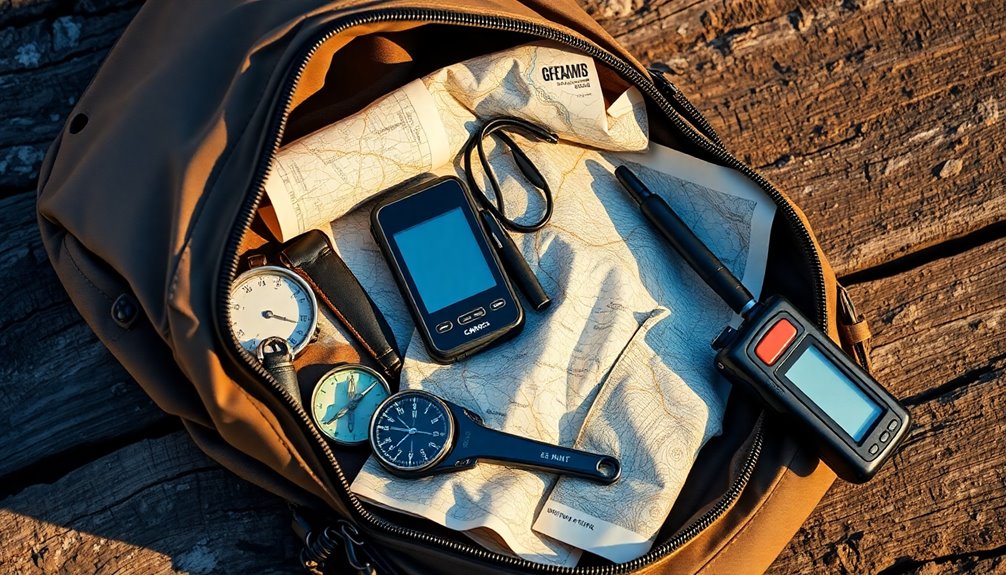
When you're in unfamiliar territory, having reliable navigation and communication tools can greatly enhance your chances of staying safe. You never know when you might need to find your way back or signal for help. Packing the right items in your bug-out bag is essential.
Here are three must-have tools:
- Map of the Area: A detailed map can guide you through local landscapes and evacuation routes. Don't underestimate its importance!
- Emergency Whistle: This small yet powerful tool can carry your distress signal far and wide, ensuring you're heard when it matters most.
- GPS Tracking System: Devices like the Garmin InReach can be lifesavers, allowing you to navigate and communicate even in the most remote areas. Just remember to pack extra batteries!
In addition to these items, consider including a sturdy compass, a signal mirror, and water-resistant note pads. These tools not only help you stay oriented but also allow you to communicate effectively in emergencies. By prioritizing navigation and communication in your bug-out bag, you'll boost your confidence and readiness for any situation. Additionally, a signal mirror can be a valuable asset for location identification, aiding in your visibility to rescuers from miles away.
Lighting and Power Sources

Staying safe in the wilderness or during an emergency often means maneuvering in low-light conditions, which makes reliable lighting and power sources essential. Start with a good headlamp for hands-free illumination; opt for an LED model for the best performance. Tactical flashlights with 200-300 lumens are perfect for versatility and can also serve as self-defense tools. Don't forget lanterns—propane, kerosene, or oil-powered options provide robust lighting, but remember to guarantee proper ventilation to avoid fire hazards. Additionally, consider adding multi-unit options for lanterns to ensure ample lighting for group scenarios.
Glow sticks and bracelets are great for tracking family members and pets in the dark, lasting up to five years. If you're concerned about battery life, include rechargeable batteries and a multi-battery charger in your kit. Always keep a spare set of batteries charging while another set is in use.
For solar power, consider fold-out solar chargers that can easily clip to your pack. High-capacity battery packs can store energy for later use, and many solar lights come with USB ports for charging devices. Finally, pack candles or tap lights as backup options—they're simple and can provide light when you need it most.
Miscellaneous Survival Gear
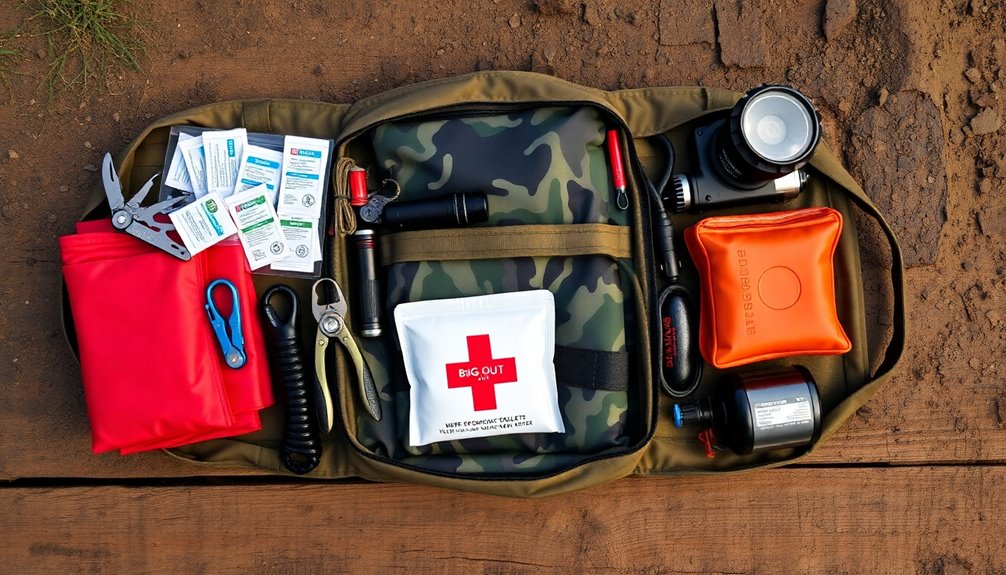
In emergency situations, having the right miscellaneous survival gear can make all the difference. You never know when you might need to improvise or tackle unexpected challenges, and these essential items can save you time and frustration.
Here are three must-have miscellaneous gear items for your bug-out bag:
- Duct Tape (e.g., 25'): This versatile tool can repair gear, create makeshift shelters, or even serve as a bandage in a pinch. It's a small item with enormous potential.
- Paracord (e.g., 550lb Paracord): Strong and durable, paracord is perfect for building shelters, securing gear, or even creating fishing lines. Its uses are only limited by your imagination.
- N95 Face Mask: In a survival situation, protecting your lungs from dust, smoke, or airborne pathogens is vital. An N95 mask can be a lifesaver when the air quality deteriorates. Additionally, having waterproof survival gear can also help ensure you stay dry and safe during adverse weather conditions.
Don't underestimate the power of these miscellaneous items. They can enhance your survival capabilities and provide peace of mind when you need it most. Equip yourself wisely, and you'll be prepared for whatever comes your way.
Frequently Asked Questions
How Often Should I Update My Bug-Out Bag Supplies?
You should update your bug-out bag supplies every 6 to 12 months. Regularly check expiration dates on food, water purification tablets, and medications to guarantee everything's still usable. Rotate your food and water to keep them fresh. Adjust your clothing and gear based on the season, and consider any personal or environmental changes that might affect your needs. Regular inspections of your gear also help maintain its effectiveness when you need it most.
Can I Pack for Multiple People in One Bag?
Imagine carrying a backpack filled with rocks during a hike; it slows you down. Packing for multiple people in one bag requires smart choices. You'll want to focus on essentials, keeping weight manageable. Choose multi-purpose items, distribute the weight evenly, and tailor supplies to individual needs. Remember, it's about survival, not luxury. Regularly check what's inside, ensuring everything's usable. That way, you'll move swiftly, just like that hiker shedding unnecessary burdens.
What Is the Best Way to Store My Bug-Out Bag?
To store your bug-out bag effectively, choose a safe and easily accessible location, like a closet or under your bed. Consider using a durable, waterproof backpack, ensuring it's comfortable for long carries. Regularly check the contents for usability, updating them as needed. Make sure all family members know where it's stored, and keep the bag organized to avoid confusion in an emergency. You'll want it ready for immediate use when needed.
Should I Include Personal Documents in My Bug-Out Bag?
Absolutely, you should include personal documents in your bug-out bag. These documents, like IDs and insurance information, are essential for your safety and security. They can help you access services or prove your identity during emergencies. Store them in a waterproof container for protection and organize them neatly. Don't forget to keep duplicates and digital backups, so you're covered if something gets lost. Regularly update your documents to guarantee they're current and valid.
How Can I Ensure My Bug-Out Bag Is Lightweight?
To achieve a featherweight bug-out bag, you’ll want to embrace the art of minimalism. Prioritize durable yet lightweight gear, like a robust bag with ample pockets. Opt for collapsible water containers and a compact water filter. Layer your clothing for versatility, and consider multifunctional tools to maximize utility. By streamlining your essentials and opting for space-efficient sleeping gear, you’ll guarantee your bag remains manageable without sacrificing preparedness. If you’re including items for your furry companion, such as a collapsible bowl and extra food, be sure to prioritize lightweight options as well. Dog bug out bags should also include a first aid kit specifically tailored for your pet, along with any necessary medications and leashes. By carefully curating your gear and considering the specific needs of your dog, you can ensure that both of your bug out bags remain lightweight and practical for any situation.
Conclusion
When you pack your bug-out bag, remember that every item could be a lifeline in a critical moment. Being prepared isn't just smart; it's the difference between thriving and merely surviving. So, don't underestimate the power of your gear—each piece is like a superhero in your fight against the unknown. As you assemble your essentials, keep in mind that your bag could mean the difference between safety and chaos in an emergency. Stay ready, stay safe!



